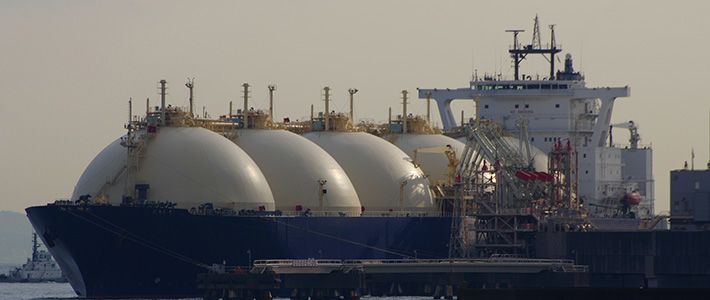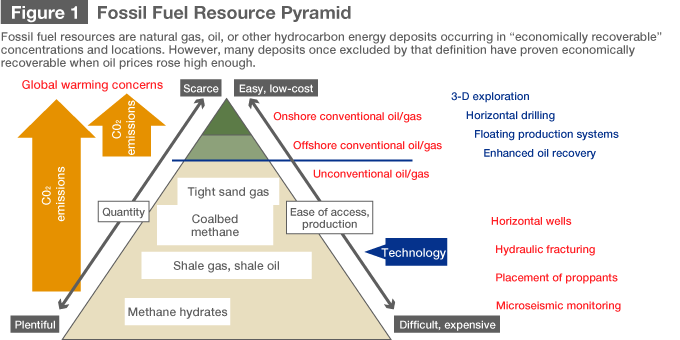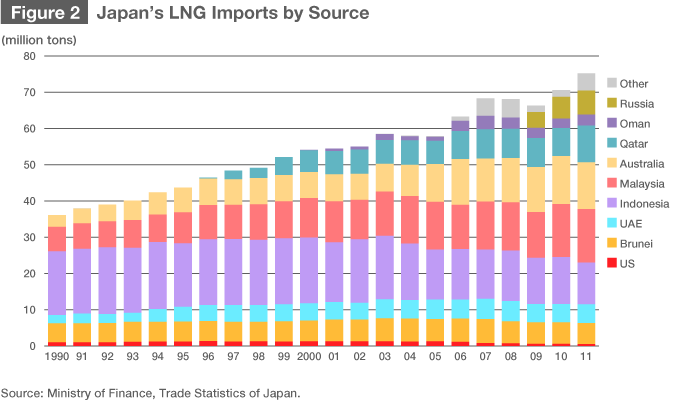
The Shale Revolution and Japan’s Energy Policy
Japanese Energy Strategy in the Shale-Gas Era
Politics Economy- English
- 日本語
- 简体字
- 繁體字
- Français
- Español
- العربية
- Русский
The shale revolution is redrawing the world energy map, and the Japanese government would do well to pay attention. Our officials have pledged to wean the nation from nuclear power and expand renewable energy. But they have had little to say about how Japan will secure the stable supplies of fossil fuels—oil, liquefied natural gas, coal, and so forth—it needs to reach those goals, and their current plans for energy procurement betray a lack of strategic thinking. Japan needs to rethink its energy policy in light of today’s new energy realities.
Gauging the Impact of the Shale Revolution
The shale revolution refers to recent advances in the extraction of natural gas and oil trapped in deposits of shale—a fine-grained sedimentary rock that splits easily along thin, parallel layers—deep beneath the surface of the earth. The idea of tapping the gas and oil potential of shale emerged earlier, during the oil crisis of the 1970s, but experts at that time concluded that development would be economically unfeasible as long as the price of crude oil stayed lower than $200 a barrel.
In the early years of this century, however, a handful of second-tier US oil and gas companies, including Chesapeake Energy and Anadarko, developed more economical techniques for tapping this resource. Once commercial shale-gas operations began in earnest in 2006, production costs fell rapidly. As a result, US natural gas prices have plunged from more than $12 per million BTUs (British thermal units) to between $2 and $3 in 2012. In terms of energy output, this is the equivalent of crude oil at a little over $10 a barrel.
The great appeal of shale gas lies in its abundance. According to estimates by the US Energy Information Administration, the United States alone has enough technically recoverable reserves of shale gas to meet 60 years worth of global gas demand. Meanwhile, energy experts see potential for shale-gas development in 32 other countries, including Australia, China, Mexico, South Africa, and Poland. Altogether, they estimate global reserves of so-called unconventional natural gas (gas requiring special extraction methods for recovery)—including “tight sand gas” in impermeable sandstone deposits and coalbed methane—at around 230 trillion cubic meters, which is substantially greater than those of conventional natural gas (181 trillion).
Market Implications
The shale revolution promises to redraw the global energy map in three basic ways.
First, it heralds America’s comeback as a top producer of fossil fuels and a diminishing role for the Middle East and Russia. Data provided in the International Energy Agency’s World Energy Outlook 2012, released in November 2011, underscores these trends. The report predicts that the United States will surpass Russia in crude-oil production by 2015 at 10 million barrels of oil per day (as compared with 6.8 million barrels in 2008), and will overtake Saudi Arabia as the world’s top oil producer by 2017, thanks mainly to shale oil. In 2012, US oil production is projected to reach 8.9 million barrels per day. As domestic production increases, dependence on oil imports will drop. In fact, the report predicts that by 2035, the United States will be all but self-sufficient in oil, and North America as a whole will become a net oil exporter.
The shale revolution, meanwhile, is on track to make the United States a net exporter of natural gas by 2020. As recently as 2004, energy experts in the United States were worrying about how to meet increasing domestic demand for natural gas and predicting that the United States would have to import 390 million tons of liquefied natural gas by 2030—roughly twice the amount then being imported worldwide. Projects were under way in Australia, Qatar, and Russia to produce LNG for the US market, and construction had begun on new LNG receiving terminals along the Gulf of Mexico. Now the forecast has changed almost overnight, from a deficit requiring 390 million tons of LNG imports to a likely surplus. (Where can all that LNG intended for the United States go now? To Japan, which has dramatically increased imports to compensate for the loss of nuclear power in the wake of 2011 Fukushima nuclear accident.)
The second way the shale revolution promises to transform the global energy market is by holding down the price of fossil fuels overall.
Some have gone so far as to predict that crude oil will drop to $50 a barrel by the end of 2012, but this ignores some basic cost realities. After all, it was high oil prices that made the shale revolution possible to start with. Extraction of shale gas and oil involves a combination of innovative technologies, including horizontal drilling (drilling parallel to the shale layer from a vertical wellbore), hydraulic fracturing (the use of pressurized liquid to fracture rock and release trapped gas), placement of proppants (to hold fractures open), and microseismic monitoring (to accurately gauge the extent of a fracture). These processes drive up production costs to the point where it makes little economic sense unless crude oil costs at least $70–$80 a barrel. If crude oil prices were to collapse, the shale revolution would grind to a halt.

On the other hand, with global energy demand exploding, US production of shale gas and oil is functioning to meet those increases and maintain an equilibrium with international oil prices at current levels. This is why crude-oil prices are likely to remain at around $80 per barrel despite rising shale-gas production.
The shale revolution is likely to have a third major consequence, namely, a negative impact on the development of renewable energy and on the environment. Many are concerned that production of shale gas and shale oil will reverse the trend toward alternative energy, which tends to be more expensive, and lead to higher dependence on fossil fuels, resulting in substantially higher emissions of carbon dioxide and other greenhouse gases.
Japan’s Muddled Energy Policy
On September 19, 2012, the Japanese cabinet approved a new energy policy built around the Energy and Environment Council’s Innovative Strategy of Energy and Environment. The strategy sets forth three basic goals: (1) reducing Japan’s dependence on nuclear energy to zero no later than the 2030s, (2) accomplishing a “green energy” revolution, and (3) ensuring stable energy supply. Unfortunately, the plan is fraught with internal contradictions and deplorably weak on strategically sound solutions for procuring a stable supply of fossil fuels until the envisioned transition is achieved.
While the plan calls for zero dependence on nuclear energy and pledges to limit the operation of reactors to 40 years, it also says that operations may be resumed for any reactors whose safety is confirmed by Japan’s Nuclear Regulation Authority. If the nation’s nuclear power plants are to resume operations, then it is essential for Japan to establish its own closed nuclear fuel cycle and find an answer to the problem of nuclear waste disposal. Yet the new strategy offers no new plans for reprocessing or disposal, merely a description of the status quo. It calls for development of renewable energy, such as geothermal and solar power and river-water heat exchange technology, yet provides no indication of how these projects are to be financed. While acknowledging the ongoing need for a stable supply of low-cost energy, it proposes nothing more concrete than upgrading and expanding thermal power generation facilities and cogeneration systems that generate both power and heat from one fuel source.
Japan’s dependence on fossil fuels has risen substantially in the wake of the 2011 disaster, as electric power utilities ramp up the operating rate of their conventional thermal power plants to make up for the loss of power from idled nuclear plants. Under these circumstances, the key prerequisite for realizing the goals of the new energy strategy is securing a stable supply of low-cost fossil fuel, be it oil, coal, or natural gas. Yet in its 15-page report, the Energy and Environment Council devoted a mere 10 lines to this challenge.
Continuing Dependence on the Middle East
Looking back over energy markets in the twentieth century—which some have termed the oil century—we can discern several distinct eras divided by periods of dynamic transition. The era up to around 1970 was dominated by the major Western oil companies. The 1970s was the heyday of the Organization of Petroleum Exporting Countries. In the 1980s, the market was driven by the energy-hungry industrialized countries. And the 1990s was an era of market competition and falling crude-oil prices.
Japan’s energy picture has changed as well, particularly in response to the oil crises of the 1970s and two lesser energy crises occurring in this century. The table below summarizes these changes.
Energy Crises and Their Impact on Japan
| First oil crisis Oct. 1973–1974 | Second oil crisis Oct. 1978–1982 | Crude-oil price spike Jan. 2007–Jul. 2008 | 2011 earthquake and tsunami Mar.–May 2011 | |
|---|---|---|---|---|
| Causes | Oil embargo by OAPEC in connection with Yom Kippur War | Suspension of oil exports by Iran following Iranian Revolution | Rise in demand from emerging markets + decline in OPEC capacity | Disruption in supply/demand balance resulting from tsunami and nuclear accident |
| Oil’s share of primary energy consumption | 77% | 71% | 43% | 42% |
| Dependence on Middle East energy imports | 78% | 76% | 80% | 77% |
| Increase in price of crude oil from pre-crisis to peak ($ per barrel) | $3–$12 400% (Arabian light) | $12–$42 350% (Arabian light) | $58–$147 250% (WTI) | $102–$99 –3% (WTI) |
| Peak crude oil import costs (CIF, ¥ per liter) | ¥21.5 | ¥57 | ¥92 | ¥58 |
| Peak gasoline price (¥ per liter) | ¥114 | ¥177 | ¥185 | ¥153 |
| Crude oil import volume (million kiloliters) | 288.61 (FY 1973) | 277.14 (FY 1979) | 224.41 (FY 2008) | 214.43 (FY 2010) |
| Days of crude oil supply in stockpiles | 67 Private: 67 Gov’t: 0 | 92 Private: 85 Gov’t: 7 | 182 Private: 85 Gov’t: 97 | 193 Private: 79 Gov’t: 114 |
| Cost of oil imports as share of imports | 23% (FY 1973) | 43% (FY 1980) | 22% (FY 2008) | 18% (FY 2010) |
| Yen-dollar exchange rate | ¥298 (August 1974) | ¥273 (November 1982) | ¥107 (July 2008) | ¥82 (March 2011) |
Source: Sekiyu shiryō (Petroleum Data), Sekiyu Tsūshinsha.
On the basis on this information, we can make the following observations.
- Japan’s dependence on oil as a percentage of primary energy use dropped from close to 80% during the 1970s to just above 40% in recent years. This was a result of energy diversification and particularly a shift toward natural gas and nuclear energy, whose shares rose to 19% and 12%, respectively. Nuclear power was the centerpiece of an energy policy geared to ensuring a stable energy supply and minimizing Japan’s vulnerability to policy changes in the oil-producing nations.
- While Japan’s dependence on oil has dropped, its dependence on Middle East sources for its energy needs has remained high, ranging from 76% to 80% throughout the period surveyed. In terms of oil stockpiles, however, our supply has grown considerably, from 67–92 days in the 1970s (with most stockpiled oil privately held) to about 193 days in recent years (with most of the reserves held by the national government).
- Between the outbreak of the first oil crisis in 1973 and the end of the second in 1982, the price of crude oil rose about 14-fold, from $3 to $42 per barrel. Viewed as a percent increase, the price spike between 2007 and 2008—from $58 to $147—was much less extreme, resulting in only a 2.5-fold jump. In absolute terms, however, the 2007–8 increase amounted to a whopping $100 per barrel.
- The cost of oil as a share of Japan’s total annual imports has fallen from 43% in fiscal 1980 to 18% in recent years. However, the main factor behind this drop has been the strength of the yen, whose value against the dollar more than tripled during this time (from ¥273 to ¥82). The amount of crude oil imported into Japan has fallen gradually, from 289 million kiloliters to 214 million kiloliters.
In sum, Japan has coped with rising oil prices by shifting to natural gas and nuclear energy, taking advantage of the rising yen, and boosting its oil stockpiles. But its heavy dependence on energy from the Middle East has remained unchanged.
LNG Imports in the Wake of Fukushima
The earthquake and tsunami of March 2011 and the resulting nuclear accident in Fukushima have removed the main ingredient of Japan’s long-term energy strategy. With most of the country’s nuclear power facilities idled, the electric power companies have sought to avoid power shortages by ramping up output from their conventional thermal power plants, which run on fossil fuels. This has made reliable supplies of oil, coal, and natural gas more important than ever.
In fact, what has saved Japan from the serious power shortages predicted in the aftermath of the March 2011 disaster has been imports of liquefied natural gas. Between 2010 and 2011, Japan’s LNG imports rose 6.6%, from 70.56 million tons to 75.21 million tons.

During the same time period, prices rose sharply, driving the annual cost of Japan’s LNG imports up by more than 50%. This trend has continued in 2012.
Imports of LNG from Qatar have grown at a particularly rapid pace. After Qatar boosted its LNG production capacity to meet a projected increase in demand from the United States, the shale-gas boom from around 2006 sharply reduced the need for US imports, leaving Qatar with a surplus. Japan has conveniently stepped in to fill the vacuum, absorbing much of this surplus LNG.
Toward a Fossil-Fuel Best Mix
The shale revolution is promising a new era of stability in the energy market, and Japan needs to take strategic advantage of its impact. To begin with, Japan currently pays 8–10 times as much for natural gas as countries in the West. This is because Japan imports almost all its gas in the form of LNG instead of pipeline gas.
LNG is natural gas converted to liquid form at very low temperatures (–162ºC). Converting natural gas to liquid form reduces the volume to about 1/600th to facilitate transport and storage. However, trading in LNG is capital-intensive and technically demanding, involving investment not only in exploration, extraction, and transport of natural gas but also in liquefaction facilities, specially designed LNG carriers, and receiving facilities. Because of this, LNG trading has traditionally revolved around long-term contracts covering 20 or 25 years. In many cases, the contract is “take or pay,” requiring payment for the pre-agreed amount even if the buyer declines shipment. Such arrangements foster the kind of long-term relationships between suppliers and buyers that are essential to LNG development projects, and they are also conducive to supply stability. On the other hand, they severely limit flexibility and inevitably result in higher prices. Recently, however, the LNG spot market has been expanding rapidly under the impact of the US shale-gas boom, and this trend is expected to accelerate. Japan should be looking carefully at options for boosting its purchases on the LNG spot market.
It is also time to reassess the strategic role of coal. Coal is relatively cheap in Japan, but it has a bad reputation because its combustion typically releases atmospheric pollutants as well as CO2 and generates coal ash that requires disposal. But according to BP data, coal is the world’s fastest-growing primary energy source, with global consumption increasing 60% between 2000 and 2010 (from 2.3 to 3.6 billion tons of oil equivalent). The main reason for this growth is the soaring demand for energy in China and other emerging economies. But coal is also a widely distributed and abundant resource, with enough proven reserves to last another 200 years. We should move forward with “clean coal” technologies, such as integrated gasification combined cycle generation and carbon capture and storage, to further diversify our mix of fossil fuels. Only by exploring all options and seeking the “best mix” can we ensure a stable energy supply in the years ahead.
United States nuclear shale gas Qatar CO2 energy thermal power imports Oil LNG Middle East fossil fuels Renewable Akio Shibata Shale revolution EIA coal Chesapeake Anadarko IEA petroleum OPEC best mix fracturing